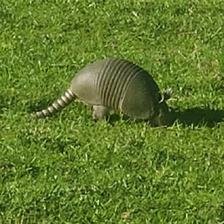
Species: Armadillo
Location: United States
Date: 2022-01-07
Time: 20:35:07.169000
Source: Animal Identifier
Location: United States
Date: 2022-01-07
Time: 20:35:07.169000
Source: Animal Identifier
The term armadillo is derived from a Spanish word meaning “little armored one,” which was given by Spanish colonialists and explorers who spotted the unusual creature upon their travels through the Americas. The Aztecs had their own term for this creature: ayotochin, a word meaning turtle-rabbit. Modern armadillos belong to the order Cingulata, a Latin word meaning girdle. It is believed that this order originated some 60 million years ago, when South America was more isolated from the North American landmass. The entire order was once far more diverse, containing a multitude of different armored animals. Today, there are only two major families of armadillos remaining: the Chlamyphoridae and the Dasypodidae. Of the two, Chlamyphoridae is the most populated. Only one genus of Dasypodidae remains, though it contains the widespread nine-banded armadillo. More distantly, the armadillo is related to anteaters and sloths.
We have observed Armadillo 20 times world wild from 2021-09-26 till this date with the last observation being in 2022-06-18 in Czech Republic.
Our data suggest that Armadillo are highly active in October, March and January world wild but differences observed on country level, while the lowest activity observed on February and September.
We noticed also the top 3 countries to observe Armadillo in are: Czech Republic, Benin and Brazil respectively.
We have observed Armadillo 20 times world wild from 2021-09-26 till this date with the last observation being in 2022-06-18 in Czech Republic.
Our data suggest that Armadillo are highly active in October, March and January world wild but differences observed on country level, while the lowest activity observed on February and September.
We noticed also the top 3 countries to observe Armadillo in are: Czech Republic, Benin and Brazil respectively.